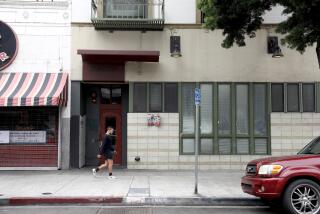The downside of upscale
- Share via
THE STEAM CLEANING of the streets of skid row a few weeks ago -- when homeless people were literally swept and hosed out of their makeshift encampments in downtown Los Angeles by employees of the local “business improvement district” -- was a troubling moment in the battle over the neighborhood’s future. But it was hardly a unique one.
In fact, the trend toward gentrification has created similar moments in cities all around the world for many years, pitting the poor and the homeless against real estate developers, the police and upscale residents returning to “reclaim” the inner city. As long as there have been low-income neighborhoods, there have been those who want to remove them -- and those who have, as a result, been left with no place to go.
For the record:
12:00 a.m. Aug. 6, 2006 For The Record
Los Angeles Times Sunday August 06, 2006 Home Edition Current Part M Page 8 Editorial Pages Desk 1 inches; 63 words Type of Material: Correction
Gentrification: A July 30 Current article on urban revitalization said the Central City East Assn. had “literally swept and hosed” homeless people from encampments on skid row when it cleaned the streets recently. Homeless people had been informed a day in advance that the street would be washed, and the organization waited until everyone was out of the way before beginning the cleanup.
The origins of the term “skid row” can be traced to Skid Road in Seattle in the 1880s, which was known for the greased corduroy track of saplings over which logs were skidded toward water to be floated to sawmills. As logging gave way to urbanization, Skid Road came to refer the area of a town where out-of-work loggers congregated. Arrival there signified that one was sliding downward in society, or “going on the skids.” During the Depression, the phrase moved south and east to denote the run-down section of any city where homeless and unemployed people clustered; by 1940, the name had changed to “skid row.”
The term “gentrification” is of more recent vintage. It hails from Britain, and was coined by the late Ruth Glass, a London sociologist, in 1964. She was worried about an emerging pattern she had identified in working-class neighborhoods of inner London: They were being “invaded,” to use her words, by members of the middle classes, who were taking over “shabby, modest mews and cottages” and upgrading large Victorian lodging houses, resulting in the displacement of the original working-class occupiers.
In the years that followed, gentrification was observed in other large Western cities, and researched extensively. It is now so firmly established in American cities that it is hard to find neighborhoods in central city areas from Boston to Chicago to Denver to San Francisco that have not experienced it. (Even Seattle’s old Skid Road is now the upscale Pioneer Square historic district, a major tourist attraction). And gentrification is an increasingly global process, observed in cities as far apart as Cape Town, Kyoto, Jerusalem and Istanbul.
Many policymakers, “business improvement” strategists, real estate agents, middle-class professionals and more conservative academics have treated gentrification as a purely positive trend, as a remedy for the human, environmental and tax-base calamity of “blighted” urban neighborhoods. But as the Central City East Assn.’s efforts to sweep and hose the streets of skid row showed, gentrifying a neighborhood often means displacing those who are already there, and displacement does not usually happen without a fight. Sure, we all like clean streets, cool bars, lattes in the sun, “authentic” historical buildings, converted lofts, art galleries and live-music spaces. But sometimes they come at too high a price.
When I first saw skid row in Los Angeles in 1994, I was appalled that this level of suffering and misery could exist in a city of such fame and wealth; I felt it even more keenly in 2002, when I attended a conference in downtown L.A. That week, a Canadian colleague informed me that there are more homeless people in downtown Los Angeles than in all of Canada -- a situation that has only been exacerbated since then by the increasingly hot property market downtown.
When it was first identified by Glass, gentrification fascinated urban planners because it contradicted the conventional mid-20th century wisdom that the middle classes would continue indefinitely to flee the cities and settle exclusively in the suburbs. The realization that some were, in fact, remaining in -- or returning to -- central city areas and rejecting suburbia came as a shock.
Explanations of gentrification have usually split into two camps. On one hand, some scholars emphasize the economic elements: the workings of urban land and housing markets, framed in the language of capital disinvestment and reinvestment. These scholars focus on the role of speculators, developers, real estate agents and mortgage lenders (usually buttressed by public policy), and argue that gentrification is a clear expression of the perennial search for profits from property.
Other scholars have taken more of a “cultural studies” tack, asking: “Who are the gentrifiers and why do they want to live in central city neighborhoods?” They’ve focused on the emergence and expansion of the “new middle classes,” their consumption practices, the ways in which (in reaction to the perceived blandness of suburbia) they imprint their identities on neighborhoods once considered off-limits.
For many years, there was considerable hostility between the two camps, sustained by political and ideological squabbles. Those who peddled the economic explanations tended to focus on the injustices of the process, whereas the cultural explainers sometimes ended up empathizing with the middle-class desire to seek out a more “urbane” existence. Today, most researchers agree that to understand and explain gentrification, the arguments must be complementary rather than competing.
Although gentrification is an increasingly global process, the most tense and violent struggles have taken place in the U.S., where the market offers limited, if any, protection to vulnerable tenants (unlike, say, Europe, where greater state intervention and regulation of rental housing tends to limit displacement). Problems in the U.S. were exacerbated during the 1980s, when the Reagan administration’s “deinstitutionalization” of psychiatric patients intensified the problems of homelessness just as the first generation of “yuppies” was seeking the edginess and convenience of urban neighborhoods.
What’s more, because gentrifiers in the U.S. are so often white, and those affected are so often members of minority groups, another layer of complexity was added to the process.
The most famous battle over gentrification took place on the Lower East Side of New York City in 1988, when a riot erupted after the police closed Tompkins Square Park in order to drive out its increasing homeless population, most of whom had been displaced because of rising rents as artists followed by young professionals moved into the neighborhood. There, as in many cases, a major role was played by both by municipal government and real estate agents, who had taken to calling the area the “East Village” in order to break associations with the poor immigrants who had dominated the Lower East Side for over a century, and thus appeal to a new wave of “urban pioneers.” It appears that a similar strategy is underway in downtown L.A., where “Central City East” is the name intended for skid row as part of the neighborhood’s “revitalization.”
The terms used in these debates are rarely innocent. “Revitalization,” for instance, suggests that right now there is nothing vital in the area. The term “urban pioneer,” so commonly given to gentrifiers, suggests no one worthy of notice is currently living there.
On the surface, gentrification can be appealing. But alfresco dining, funky clothing outlets and “historic preservation” can be deceptive. Gentrification is a serious issue when housing laws fail to protect tenants, when affordable housing is nonexistent and when no new public housing is being built because of widespread fears of re-creating the unacceptable conditions of L.A.’s existing housing projects, like Imperial Courts in Watts.
Even if people are not made homeless, the conversion of dilapidated hotels into swanky apartments means there that are fewer housing options for poorer citizens, and if this happens on a large scale, it puts massive pressure on already stretched voluntary organizations, charities and social assistance providers.
People living on the streets and in the single-room-occupancy hotels of downtown L.A. have enough to cope with already without being hosed out of the way for iPod-wearing, latte-drinking professionals strolling to work in Bunker Hill. If urgently needed change in downtown L.A. is to improve life at all for those who live there now, some provision must be made for adequate, affordable housing.
Caps on loft conversions, greater rent protections for tenants and subsidies for people unable to afford rental housing would also help ensure that poverty is not simply moved elsewhere.
If the debate about skid row is to be productive, we need to reject the characterizations of its dwellers as unfortunate failures and instead evaluate the ways in which a booming housing market can do damage -- economic, social and psychological -- to those who live in poor, underserved neighborhoods.
More to Read
Sign up for Essential California
The most important California stories and recommendations in your inbox every morning.
You may occasionally receive promotional content from the Los Angeles Times.






